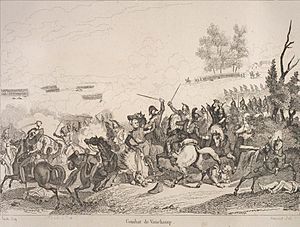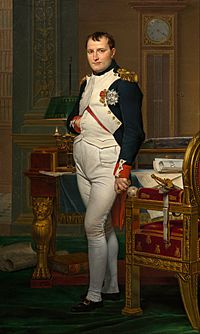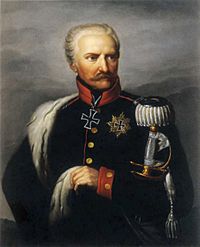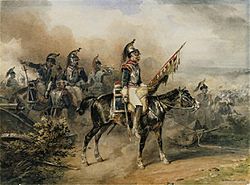Battle of Vauchamps facts for kids
Quick facts for kids Battle of Vauchamps |
|||||||
|---|---|---|---|---|---|---|---|
| Part of the Campaign of France of the Sixth Coalition | |||||||
 Engraving |
|||||||
|
|||||||
| Belligerents | |||||||
| Commanders and leaders | |||||||
| Strength | |||||||
| 10,000-11,000 | 16,000-21,500 | ||||||
| Casualties and losses | |||||||
| 600-1,000 killed, wounded, or captured | 6,000-9,000 killed, wounded, or captured 15 guns lost |
||||||
The Battle of Vauchamps happened on February 14, 1814. It was the last big fight in the Six Days Campaign, which was part of the War of the Sixth Coalition. In this battle, the French army, led by Emperor Napoleon, won against a larger army from Prussia and Russia. This enemy army was called the Army of Silesia and was led by Field-marshal Gebhard Leberecht von Blücher.
In early 1814, Napoleon's French Empire was trying to defend eastern France from invading armies. Even though he was fighting against much bigger forces, Napoleon managed to win several important battles. Between February 10 and 13, he repeatedly defeated Blücher's Army of Silesia. On February 13, after these losses, Blücher decided to move away from Napoleon. Instead, he planned to attack a smaller French group, the VI Corps, led by Marshal Marmont, which was protecting Napoleon's rear. Blücher attacked Marmont's forces late on February 13 and pushed them back. However, Napoleon had guessed Blücher's plan and sent strong forces to help Marmont.
On the morning of February 14, Blücher, with Prussian and Russian soldiers, attacked Marmont again. Marmont's troops kept falling back until Napoleon arrived with many soldiers and cannons. This allowed the French to launch a strong counterattack and push back Blücher's leading troops. Blücher then realized he was fighting Napoleon himself and decided to retreat to avoid another battle. But it was hard for Blücher to pull back because his army was far forward, had almost no cavalry (horse soldiers) to protect their retreat, and was facing a French army with lots of cavalry ready to attack.
The main battle itself was short. However, the French foot soldiers, led by Marshal Marmont, and especially the cavalry, led by General Grouchy, chased the enemy without stopping. The enemy soldiers were retreating in slow-moving square formations in broad daylight, across open land perfect for cavalry. Because of this, Blücher's forces suffered very heavy losses, with several of their squares broken by the French cavalry. When night came, the fighting stopped. Blücher chose to march all night to get his remaining soldiers to safety.
Contents
Why the Battle Happened
On February 13, Napoleon had already won three battles in three days against the Prussian and Russian armies at Champaubert, Montmirail, and Château-Thierry. He was chasing the defeated enemy. After these losses, Field-marshal Blücher decided to avoid Napoleon and instead move a large part of his army to attack Marshal Marmont's isolated French army group at Étoges. Blücher knew Marmont's group was weak. His plan was to destroy it and then attack Napoleon's main army from behind.
Late on February 13, while still chasing the enemy, Napoleon received news that Marmont's group had been attacked and pushed out of Étoges. The Emperor figured out that the enemy force in front of him must be much smaller. He quickly decided to go help Marmont. Napoleon left Château-Thierry very early on February 14, around 3 AM. He left a small part of his forces with Marshal Mortier to keep chasing the enemy. Taking his best cavalry and General Grouchy's cavalry, Napoleon headed for the village of Vauchamps.
Meanwhile, late on February 13, Blücher had gathered his forces at Bergères-lès-Vertus. He then attacked Marmont's single division, pushing them out of Étoges. He advanced towards Champaubert and Fromentières, which was behind Napoleon's main force, just as he planned. However, Napoleon had already guessed Blücher's intentions and had ordered French forces to gather in that exact area.
Who Fought in the Battle
On February 14, Field-Marshal Gebhard Leberecht von Blücher led the combined Prussian and Russian Army of Silesia. He had about 20,000 to 21,500 soldiers from three army groups:
- The Prussian II Corps, led by General Kleist.
- The Russian IX Corps.
- The Russian X Corps, led by General Kaptzevich.
Kleist's Prussian Corps had about 13,500 men. Kaptzevich's Russian Corps had 6,500 men. There were also about 1,500 soldiers from the IX Corps who had survived an earlier battle. These were put into small groups with some cannons.

Napoleon had ordered many French forces to gather, bringing together about 25,000 men in this area. However, only about 19,000 soldiers arrived in time for the battle. Of these, only about 10,000 actually fought:
- The VI Corps, led by Marshal Marmont.
- Cavalry (horse soldiers), led by General Grouchy.
- The Guard cavalry, Napoleon's elite horse soldiers, led by General Nansouty.
- The Guard artillery, cannons led by Drouot.
- The Guard infantry, Napoleon's elite foot soldiers, led by Marshal Ney (these arrived but did not fight much).
Grouchy's cavalry had about 3,600 horsemen. The Guard cavalry had 3,300 horsemen. Marmont's two divisions had only 3,000 men. Other divisions brought more soldiers, but only the cavalry and Marmont's foot soldiers, plus a small part of the Old Guard, were directly involved in the fighting. The rest were marching behind.
The Battle Unfolds
Blücher's forces had started pushing back Marmont's small French group the day before. On February 14, Blücher took over Champaubert early in the morning. He sent his leading troops as far as Fromentières and then Vauchamps. Marmont, with only a small number of soldiers, had carefully pulled his men back towards Montmirail, where he started getting more troops. Around 9 AM, Blücher sent his troops towards Montmirail. To their surprise, Marmont's men did not retreat this time. They fought back strongly, pushing Blücher's leading troops back into Vauchamps. The Prussian cavalry with them was scattered by strong French cannon fire.
With more of his troops available, Marmont attacked the Prussian position at Vauchamps. His soldiers advanced from both sides of the road. Marmont also had his own cavalry and some elite Imperial Guard cavalry with him. Marmont's left group entered Vauchamps, but the village was strongly defended by the Prussians. The French were soon pushed back, with the Prussians chasing them. Marshal Marmont then sent his cavalry to help. The cavalry quickly forced the Prussians back to the village, capturing one of their groups of soldiers who had hidden in a farm.
Blücher's general, Zieten, then decided to pull his forces back towards Fromentières. There, Zieten was joined by Generals Kleist and Kapsevitch, who had heard the fighting and were moving their army groups in that direction from Champaubert. The French also moved forward, with Marmont's two divisions chasing Zieten along the road to Fromentières. Marmont was now supported on his left by General Grouchy, who had just arrived with his cavalry. Grouchy moved to cut off Zieten's retreat. More French help arrived on Marmont's right: a division that had been moving up the valley to outflank the Prussians. With the French Imperial Guard cannons also firing, Zieten's Prussians retreated in good order, forming squares to defend against Grouchy's cavalry. Around 2 PM, after seeing the situation, Blücher realized he was facing Napoleon himself. He decided to retreat immediately. He ordered all his forces to pull back through Champaubert and sent some of his cannons to safety towards Étoges.
The Chase Begins
With the enemy forces now fully retreating, Marmont was ordered to chase them aggressively. He knew he had his two infantry divisions, plus another, as well as support from General Drouot's Guard artillery and General Nansouty's Guard cavalry on his right, and General Grouchy's two cavalry divisions on his left. Following Marmont closely were more French reinforcements, two Guard infantry divisions under Marshal Ney, and Napoleon himself. Napoleon was also followed by another "Young Guard" division.
The French cavalry had been slowed down by the rough ground and hadn't been able to seriously bother Zieten's infantry squares (a defensive formation). Because of this, Blücher was able to lead a good retreat up to Fromentières. However, once past these villages, the land became flat and open, perfect for cavalry. Now, with the enemy cavalry attacking his side and rear more and more, Zieten and his group became more and more isolated. Grouchy's cavalry was boldly threatening Zieten's right side. On Zieten's left, the Prussian general saw Nansouty's Guard cavalry. Zieten's group was finally cut off from the rest of the army and fiercely attacked by Grouchy's heavy cavalry (cuirassiers). They broke the infantry squares and captured at least 2,000 prisoners, with the rest of the group scattered.
Leaving his position at Fromentières, Blücher ordered the retreat to continue towards Champaubert and Étoges. Kleist's Corps was on the left, south of the road, and Kaptzevitch's Corps was on the right, north of the road. Again, taking advantage of the flat land, Grouchy's cavalry moved quickly and attacked the rear of the enemy infantry squares. These squares were slowly retreating in a staggered line and using the land to protect themselves from cannon fire. As night approached and their retreat towards Étoges was blocked by enemy cavalry, the Prussian squares began to break apart. Seeing this weakness, Grouchy, who had been joined by another cavalry division, strongly launched his three divisions against the enemy squares. Many of them scattered, with soldiers fleeing in disorder to hide in the Étoges forest. The old Blücher, who had bravely put himself in danger to encourage his men, was almost captured, along with his chief of staff and other generals.
Barely escaping capture, Blücher crossed the forest and took up positions at Étoges with a Russian division that had been left there as a reserve. Russian General Udom, with 1,800 men and 15 cannons, was told to protect the position by holding the park at Étoges. Udom's men were tired after the long retreat and fighting. Since night had fallen, they thought they were safe. However, Grouchy's heavy cavalry, formed unseen in the dark, surprised these men. A single charge was enough to send the panicked soldiers fleeing. A Russian Prince, 600 men, and eight cannons were captured during this action. Blücher left this position too and made a quick night retreat towards Vertus and Bergères. He then chose a fast night march. The next day, he managed to bring his remaining men to Châlons, where he was joined by other army groups.
What Happened After
The Battle of Vauchamps was mostly a very long chase by the French cavalry. It was a very costly defeat for Blücher's "Army of Silesia", which lost as many as 10,000 men that day. One French writer, Jean-Pierre Mir, says that the Prussian Corps of Kleist lost 3,500 men (killed, wounded, and missing) and 2,000 prisoners. According to him, the Russian Corps lost about 3,500 men (killed, wounded, or missing) and also lost 15 cannons and 10 flags. Another historian, Alain Pigeard, says the total losses for the Army of Silesia that day were between 9,000 and 10,000 men. However, his detailed numbers suggest fewer casualties. Pigeard says only 1,250 men were killed, wounded, or missing, and 2,000 Prussians were captured. He also says 2,000 Russians were lost. The French had very light losses, around 600 men.
Military historian Jacques Garnier noted that only the muddy, wet ground, which made it hard for the French cannons and foot soldiers to move well, stopped Napoleon from winning an even bigger victory. He also pointed out that after Vauchamps, Napoleon was able to safely turn south and attack the "Army of Bohemia" at the Battle of Mormant, which was led by Prince of Schwarzenberg.



